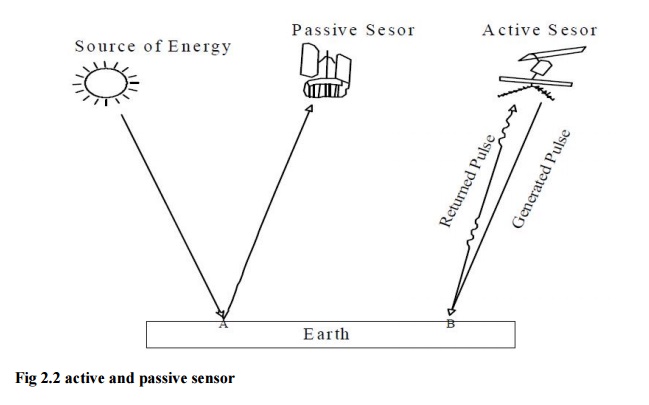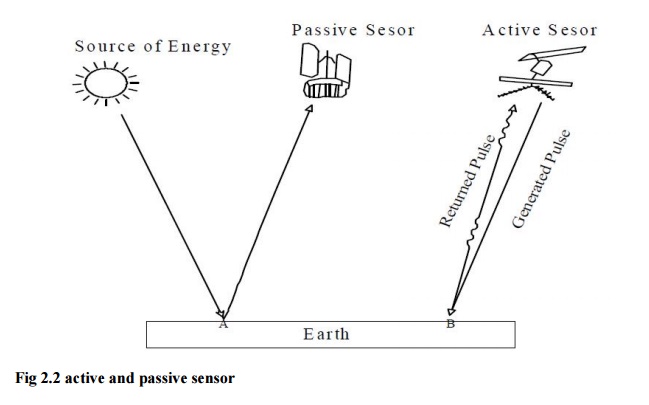Chapter: Civil : Remote Sensing Techniques and GIS : Platforms and Sensors
Passive and Active Sensors

PASSIVE AND ACTIVE SENSORS
Remote sensors are the instruments which detect various objects
on the earth's surface by measuring electromagnetic energy reflected
or emitted from them. The sensors are mounted on the platforms discussed above.
Different sensors record different wavelengths bands of electromagnetic energy coming
from the earth's surface. As for example, anordinary camera is the
most familiar type of remote sensor which uses visible portion of
electromagnetic radiation.
Classification
of Sensors
Remote
sensors can be classified in different ways as follows.
1. On the Basis of Source of Energy Used: On the
basis of source of energy used by the sensors, they can be classified into two
types - Active
sensors and Passive sensors.
2.3.1ACTIVESENSORS: Active
sensors use their own source of energy and earth surface is illuminated by
this energy.
Thenapartofthis energy is reflected back which is received by
the sensor to gather information about the earth's surface
(Fig.3).
When photographic camera uses its flash, it actsasan active sensor.
Radar and laser altimeterare active sensors. Radar is composed of a transmitter
and a receiver. The transmitter emits a wave, which strikes objects and is then
reflected or echoed back to the receiver. The properties of an active sensor
are: 1) It uses both transmitter and receiver units to produce imagery, hence
it requires high energy levels. 2) It mostly works in microwave regions of EMR
spectrum, which can penetrate clouds and is not affected by rain. 3) It is an
all weather, day-night system and independent of solar radiation. 4)The RADAR signal
does not detect colour information or temperature information, but it can
detect the roughness, slope and electrical conductivity of the objects under
study.
2.3.2.
PASSIVE SENSORS: Passive sensors do not have their
own source of energy. The earth surface is illuminated by sun/solar
energy. The reflected solar energy from
theearthsurfaceortheemittedelectromagneticenergybytheearthsurfaceitself is
received by the sensor (Fig.3). Photographic camera is a passive sensor when it
is used in sunlight, without using its flash. The properties of a passive sensor
are:
1)It is relatively simple both mechanically and electrically
and it does not have high power requirement.
2) The wavebands, where natural remittance or reflected levels
are low ,high detector sensitivities and wider adiation collection apertures
are necessary to obtain areasonable signal level. Therefore, most passive sensors
are relatively wide band systems. 3) It depends upon good weather conditions.
2. On the Basis of Function of Sensors: On the basis
of function of sensors, they are divided into two main types - Framing System
and Scanning System.
a. Framing system: Inframing
system, two dimensional images are formed at one single instant. Here, alensisused
together the light which is passed through various filters and then focused on
a flat photo sensitive target. In ordinary camera, the target is film emulsion,
where asinvidicon camera, thetargetis electrically charged plate.
b. Scanning System: In scanning system, asingle detector/anumberofdetectors
with specific field of view, is used which sweeps across a scene in a series of
parallel inesand collect data for continuous cellsto produce an image. Multi
Spectral Scanner, Microwave Radiometer, Microwave Radar, Optical Scanners are
few examples of scanning system sensors.
3. On
the Basis of Technical Components of the System: The sensors can be classified
into three categories on the basis of technical components of the system and the
capability of the detection.
Theseare:1)Multispectralimagingsensorsystems,2)Thermalremote sensing systems,
and 3) Microwave radar sensing systems. The multispectral or multiband imaging
systems may use conventional type camers or may use a combination of both cameras
and scanners for various bands of electromagnetic energy. As for example, Return
Beam Vidicon (RBV) sensor of Landsatuses both photographic and Scanning
systems, which is similar to an ordinary TV camera. The thermal system uses
radiometers, photometers, spectrometers, thermometers to detect the temperature
changes where microwave sensing systems use the antenna arrays for collecting and
detecting the energy from the terrain elements.

Related Topics